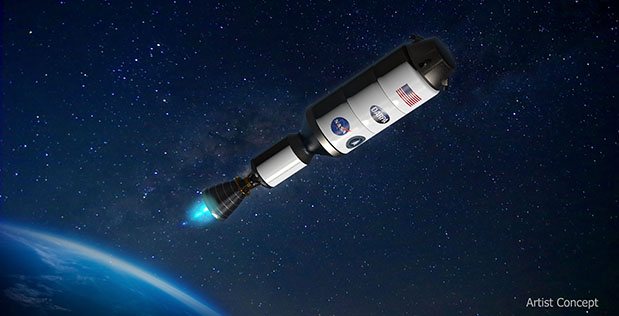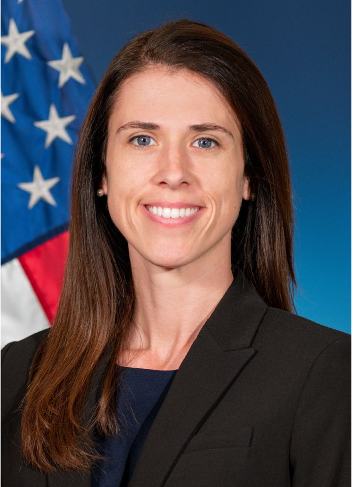Nuclear Propulsion Systems for Space Exploration
DARPA’s DRACO Project
Tabitha Dodson
DRACO Program Manager
DARPA
Sponsored by Enig Associates, Inc.
About the Lecture

DARPA, in collaboration with NASA, is advancing toward the goal of the world’s first in-orbit demonstration of a nuclear thermal rocket (NTR) engine via the DRACO project (Demonstration Rocket for Agile Cislunar Operations). DARPA has finalized an agreement with Lockheed Martin for the company to begin work on the fabrication and design of the experimental NTR vehicle (X-NTRV) and its engine.
The DRACO program aims to give the nation leap-ahead propulsion capability. An NTR achieves high thrust similar to in-space chemical propulsion but is two-to-three-times more efficient. A successful demonstration of an NTR could significantly advance humanity’s means for going faster and farther in space and pave the way for the future deployment for fission-based nuclear space technologies.
Towards that end, in January of this year (2023), DARPA and NASA signed an agreement to collaborate on developing a NTR engine, with an initial focus on providing the means to more efficiently and quickly transport material through the cislunar domain, and the longer term aim of people to Mars.
The DRACO program takes advantage of the nation’s early investments in nuclear thermal technology via the previous Nuclear Engine for Rocket Vehicle Applications (NERVA) program, but with a new fuel option that presents fewer logistical hurdles. DARPA is using high-assay low-enriched uranium (HALEU) fuel, made possible via National Security Presidential Memorandum 20 (NSPM-20), which updated U.S. policy for the launch of space nuclear power and propulsion. As an additional safety measure, DARPA will engineer the system so that the engine’s fission reactor will stay turned off until it reaches its designated orbit.
The U.S. Space Force will provide the launch vehicle that will take the X-NTRV into space in 2027. The Department of Energy will provide HALEU metal. BWX Technologies (BWXT), one of Lockheed Martin’s partners in the effort, will develop the nuclear reactor and fabricate the HALEU fuel.
This lecture will discuss the history of NTR R&D efforts, the current DRACO program, and the prospects for NTR-enhanced space transportation and exploration, particularly regarding cis-lunar operations, NASA’s Artemis Program, and voyaging to Mars and beyond.
About the Speaker

Tabitha Dodson is the Program Manager for the Demonstration Rocket for Agile Cislunar Operations (DRACO) program. Her interests focus on advanced space payloads, electric propulsion, astrodynamics, nuclear thermal and nuclear electric propulsion, overall rocket propulsion, advanced nuclear reactors, plasma physics and plasma engineering, nuclear/quantum/particle physics, and hypersonics.
Prior to becoming a program manager at DARPA, she was a Systems Engineering and Technical Assistance contractor with Gryphon-Schafer Government Services, LLC (within DARPA), where she served as the chief engineer of the DRACO program to build and test a nuclear thermal rocket. Upon becoming a government employee with DARPA she continued to serve as DRACO’s chief engineer, and also served as its deputy program manager.
Dodson has also served as Adjunct Professor of Aerospace Engineering at the United States Naval Academy and as Adjunct Professor in the Aeronautics and Astronautics Department of the Air Force Institute of Technology (AFIT). And she has held a variety of other positions within and for the U.S. Air Force, including as an aerospace engineer and senior scientist in the fields of spacecraft engineering, space missions and operations, space power, and space propulsion.
Dodson earned a BS in Physics, Sociology and Anthropology, an MS in Space Policy and a PhD in Mechanical and Aerospace Engineering at the George Washington University and, in addition, a PhD in Applied Physics at the Air Force Institute of Technology.
Minutes
On September 8th, 2023, from the Powell Auditorium of the Cosmos Club in Washington, D.C, and by live steam broadcast on the PSW Science YouTube channel, President Larry Millstein called the 2,480th meeting of the Society to order at 8:02 PM Eastern Time.
It being the annual meeting President Millstein reported the state of the Society for the fiscal year ending June 30, 2023. He noted that membership applications and total membership increased over the previous year, dinner attendance was back to pre-pandemic levels but combined in-person and live stream lecture attendance still somewhat lagged. He noted that the videos on YouTube most widely promulgate the Society's programming. There are now 199 videos in fifteen playlists, he said, collectively garnering over 850,000 views. Newly posted videos were viewed several hundred to several thousand times in the first two weeks after posting. Sean Carroll's video, he noted, had been viewed over 125,000 times, and there are now about 9,500 subscribers to the PSW YouTube Channel.
He reported that the Audit Committee had examined the books for the year, and he read their report that they found the books in order and did not find any material irregularity. He reported that the Society ended the year in the black despite the tripling of the Cosmos Club's charges, thanks - he said - to major donors and lecture sponsors, as well as dues and contributions by the membership. And he noted that the Society's reserves continued to grow and remain adequate relative to annual expenses.
President Millstein then thanked PSW Member Mike Helton and Helton Associates, PSO/APU, PSW Member Tim Thomas and PSW Member Eric Enig and Enig Associates for their sponsorships. He then introduced new members.
PSW Member Erica Kane than read the minutes of the 2,479th meeting and the lecture by Bill Merrell and Sam Brody on The Ike Dike Project to Protect Texas Coasts, prepared by PSW Recording Secretary Cameo Lance, who was unable to attend the meeting. There were no comments on minutes, they were approved by voice vote of the members in attendance, and President Millstein announced that they would be posted to the website in due course.
He then introduced the speaker for the evening: Tabitha Dodson, Program Manager for DARPA's Demonstration Rocket for Agile Cislunar Operations (DRACO) program, and her lecture on “Nuclear Propulsion Systems for Space Exploration.”
Dodson began by explaining that her talk would span many different topics including aerospace rockets, the nuclear reactors, and element, and a variety of political and legal issues affecting the program.
She then explained that DARPA's DRACO program is a partnership with NASA, and that Lockheed Martin is the prime contractor. Funding, she said, comes from Space Force, NASA, and DARPA in equal parts. She then reviewed DARPA as an organization and explained a bit about how it works.
By way of introduction to DRACO, Dodson then played a video of President Kennedy's well-known speech announcing the nation's goal of placing a man on the moon by the end of the decade. But she highlighted a later and less famous part of the speech in which Kennedy announced another goal: developing a nuclear rocket to facilitate man's progress into space. She explained that that goal was only partially carried out through the NERVA project that engineered, produced and tested a nuclear powered rocket engine. The DRACO project, she noted, builds on the experiences and test results the NERVA project achieved.
She began the technical portion of the talk by explaining some fundamental of rocket engines, such as the importance of specific impulse to reduce propellant mass for a given thrust, and she reviewed differences between chemical thrusters, electric thrusters, and nuclear thrusters.
She then reviewed key terms for understanding the structure and functioning of nuclear reactors, including terms describing different types of nuclear fuel, such as highly enriched uranium used in military reactors and the kind of fuel planned for DRACO utilizing low enriched uranium embedded in a matrix.
Dodson then explained some fundamentals of nuclear thermal rocket construction and performance, explaining the pump, turbo machinery, the reactor core, the fuel and its geometry, and methods for controlling thrust.
Next the speaker reviewed key differences between terrestrial nuclear power and nuclear thermal rockets. One key difference, she said, is the operating core temperature. Terrestrial reactors operate between 300 degrees Celsius for pressurized water reactors to 1000 degrees Celsius for gas cooled reactors. Nuclear thermal reactors for space propulsion will operate at much higher temperatures, around 2500 – 3000 degrees Kelvin.
She then reviewed the basic operation of nuclear thermal rockets, and showed diagrams of the fuel and control tube assemblies and of the general layout and operation of the reactor. She reviewed the basic fission process, emphasizing that nuclear fission is a fairly well characterized problem of statistics, with the goal of increasing the population of neutrons in one concentrated area and influence the energy distribution of the neutrons there to increase the probability of fusion.
The speaker then turned to the DRACO program itself. She started by highlighting five operational guiderails and goals of the program: conduct no full-power tests on the ground; utilize cryogenic liquid hydrogen; use high assay low enriched uranium fuel ("HALEU"), launch in 2027, and focus on collecting data on HALEU fueled nuclear thermal reactor characteristics and performance..
She explained that DARPA particularly interested in understanding thermal feedback effects, which will likely occur and can then be studies at start-up of the DRACO engine. She reviewed the possible preliminary DRACO test matrix, and discussed examples of preliminary engine start up results, including general design criteria.
She speaker then discussed the status of the program and the milestones the program is expected to reach in the future.
Dodson concluded the lecture by enumerating some of the benefits of nuclear thermal rockets. She said, in particular, that they can deliver heavier payloads, deliver payloads faster, perform more maneuvers, and maneuver more aggressively.
After the lecture concluded there was a question and answer period.
One member asked what the drums are and why rotating them is so exciting. Dodson responded that the drums are long beryllium cylinders with asymetric inner coatings so that in one orientation they primarily reflect neutrons and in the opposite orientation they primarily absorb neutrons. Thus, a relatively simple rotation of the drum reorients the beryllium cylinders and moderates the intensity of the fission reactions in the uranium fuel.
Another member asked what it would take to turn a nuclear thermal rocket engine into a power source. The speaker explained that the coolant loop for the propellent would the be used to cool all of the various constituent elements. So the coolant would go in a tie tube and out of the core and eventually back down to the fuel. However, for a power reactor it would only go through the tie tube and not through the fuel.
After the question and answer period, President Millstein presented the speaker with a copy of the announcement of her lecture signed by the General Committee, a PSW ribbon and a copy of Volume 1 of the PSW Bulletin signed on behalf of the members. And he thanked the speaker for spending her time with PSW and for giving the lecture.
He then made some housekeeping announcements, discussed up-coming lectures, and invited guests to join the Society. He adjourned the meeting on vote of the members present at 9:38 PM.
Temperature in Washington, D.C.: 22° C
Weather: Cloudy
Live attendance: 117 (66 in person and 51 viewing on YouTube).
Views of the video recording on YouTube in first two weeks after the lecture - 778.
Respectfully Submitted,
on behalf of Recording Secretary Cameo Lance